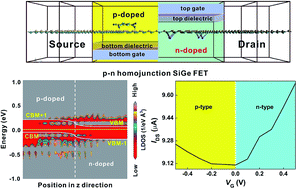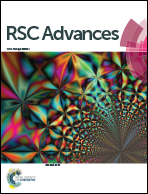Theoretical study of a p–n homojunction SiGe field-effect transistor via covalent functionalization†
Abstract
p–n homojunctions are superior to p–n heterojunctions in constructing nanoscale functional devices, owing to the excellent crystallographic alignment. We tune the electronic properties of monolayer siligene (SiGe) into p/n-type via the covalent functionalization of electrophilic/nucleophilic dopants, using ab initio quantum transport calculations. It is found that the n-type doping effect of K atoms is stronger than that of benzyl viologen (BV) molecule on the surface of SiGe monolayer, owing to the strong covalent interaction. Both of p-type 2,3,5,6-tetrafluoro-7,7,8,8-tetracyanoquinodimethane (F4TCNQ)-adsorbed and n-type 4 K-adsorbed SiGe systems show enhanced optical absorption in the infrared region, indicating their promising applications in infrared optoelectronic devices. By spatially adsorbing F4TCNQ molecule and K atoms on the source and drain leads, respectively, we designed a p–n homojunction SiGe field-effect transistor (FET). It is predicted that the built F4TCNQ-4K/SiGe FET can meet the requirements for high-performance (the high current density) and low-power (low subthreshold swing (SS)) applications, according to the International Technology Roadmap for Semiconductors in 2028. The present study gains some key insights into the importance of surface functionalization in constructing p–n homojunction electronic and optoelectronic devices based on monolayer SiGe.



 Please wait while we load your content...
Please wait while we load your content...